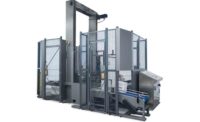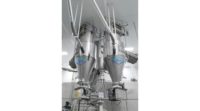When it comes to product handling equipment, snack producers and bakeries are looking for flexible machines that can run a variety of products and offer quick or completely automatic changeovers. Gentle product handling is a high priority, and there is great interest in robotics to complement the performance of cartoners, case erectors and packers, loaders, and palletizers.
“We see bakery/snack producers rapidly shifting toward automation,” says Nate Lee, regional sales manager, BluePrint Automation, South Chesterfield, VA. “One of the driving factors is the current 3 percent unemployment rate; there are not enough people to fill open positions. This is forcing the industry to look at utilizing more vision-guided, pick-and-place solutions.”
Rick Hoskins, president, Colborne Foodbotics, Lake Forest, IL, says the trend to more-flexible packing systems has returned to the forefront of customer needs. “Dedicated lines are fewer. While many of the products being packaged are similar from a processing standpoint, they are being packed in different ways and formats. We now offer systems that pack cartons, clamshells and individual wrappers.”
Today’s systems are able to create more-complicated carton types, as well as shelf-ready display packages, according to Peter Fox, vice president of sales, Somic America Inc., Wytheville, VA.
“Thanks to advanced servo technology and sophisticated machine-control systems, carton-forming systems are able to incorporate sophisticated carton designs that include features such as stack shoulders, folded front display panels and similar features for robust display packaging,” Fox says. “This leads directly into retail-ready display packaging. Gentle product handling during the packaging process, along with advanced forming and folding technologies, give the bakery/snack market more automated options.”
Equipment innovations
The latest product handling equipment features modular designs and sophisticated electronics. For example, A-B-C Packaging Machine Corp., Tarpon Springs, FL, has introduced a robotic packer and palletizer with integrated electronic controls that simplify operation and changeover. “This modular, future-proof machine is designed to adapt to changing packaging requirements,” says Bryan Sinicrope, vice president of sales and marketing.
BluePrint Automation has developed an integrated secondary case packing solution designed to increase packaging speeds and efficiencies while reducing floor space with enhanced ease of operation. “The modular design offers greater flexibility to meet customers’ specific needs while meeting demand for greater food safety, operator access and sanitation,” Lee says.
The Osprey robotic case packer from JLS Automation, York, PA, is designed to handle bakery products such as tortillas, flatbreads, muffins and snack cakes. It automatically loads packaged product into cases (regular slotted carton, half slotted container and retail-ready) and trays. Multiple end-of-arm tooling (EOAT) options are available to handle uniform-size packages, as well as those that are hard to handle. “The case packer integrates motion, logic, safety and human-machine interface into a single scalable platform,” says Craig Souser, president.
Colborne Foodbotics’ cupcake and muffin depanning technology features an innovative end effector design that has evolved over the years, according to Hoskins. “Our tools allow equipment to pick up injected and multi-layered products without causing damage or excessive buildup on the tool. Filled and multi-layered products represent a big trend in the cake business.”
Somic has developed a Lamella Chain vertical collator, which collates at high speeds while offering delicate handling. In addition, the carton erecting and folding occurs while the product is protected inside a metal forming cassette. “All of our machines are created from modular functional groups. This enables us to customize our standard retail-ready and wraparound machines to the products and formats we package,” Fox says.
Honeywell Intelligrated, Mason, OH, recently introduced IntelliGen robotic palletizing software, allowing operators to simply adjust load patterns and stacking characteristics based on changing product dimensions and other variables. The company also deploys servo technology in conventional palletizing machines that helps maximize production rates and minimize product damage. “With this technology, tuning parameters can be adjusted on-the-fly to adapt machine handling characteristics. This improves handling of complex or fragile products,” says Doug Stoll, product manager, palletizing.
Robotic solutions
Integration of robotics is growing, notes Jack Uhl, regional sales manager, Yaskawa America Inc., Motoman Robotics Div., Miamisburg, OH. “High-speed picking robots are now commonly used for placing baked goods into arrays, thermoformers, cavities and containers with precision and less damage to products. Advances in intelligent ‘finger-type’ tooling complement this process by emulating the human aspect, while maintaining sanitation and repeatability. Downstream, in secondary packaging, robots permit fast changeover as SKUs are increased with shorter production runs.”
For many years, robotics has been limited to palletizing and case packing, says Sub Datta, chief business officer, Soft Robotics Inc., Cambridge, MA—but that is beginning to change. “With the introduction of Soft Robotics, robots can now meet the automation challenges of key industries, such as bakery/snack food. For example, one global pizza retailer and e-commerce company ships its dough fresh to retail locations around the world. Due to the variable and delicate nature of the dough balls, the company had been trying for two years to automate the manipulation and packaging of the end-product.”
Soft Robotics was able to develop a customized solution to meet the challenge, Datta notes, with a robotic solution that can dexterously grasp and maneuver the dough at high speeds.
EOAT advances
EOAT for picking and handling food products and packages continues to advance as well, handling delicate bakery goods without damaging product at high speeds. This includes placing caps on cookies and loading trays of crackers at high speeds, notes Lee.
Developments in robotic tooling include the use of soft, collapsible fingers adjustable to a set of product profiles and dimensions to avoid crushing the product, notes Uhl. The tools can operate at high speeds and handle a wide range of shapes, profiles and sensitivity levels.
“End effector design is the core engineering value that is created and makes the difference between a great system and just another machine,” says Hoskins. “We have many tools that handle a wide variety of products. They are all custom-made around a particular solution.”
New product-handling systems improve worker safety by reducing repetitive stress. “Soft Robotics’ grippers are made of soft, compliant materials, enabling humans to work side-by-side with robots that, even when operating at high speeds, are safe, adaptable and easy to use,” Datta notes.
Bakery trays from Rehrig Pacific Co., Los Angeles, also are designed to reduce repetitive stress, according to Glenn Rindfleisch, director, bakery division. The company’s Stack King helps bakers maneuver full and empty stacks of bakery trays in order to maximize cube utilization and reduce transportation costs.
“Our customers identified that the Stack King improved worker safety and reduced the likelihood of unsafe repetitive motion by 95 percent. Customers now use the Stack King to safely up-stack, sort, load, unload, select and down-stack trays of all types. EOAT turns an easy-to-operate base unit into a customized solution for various applications,” Rindfleisch says.
Looking ahead, Uhl predicts that vision technologies will continue to advance, with 3D becoming more common. “Downsizing the physical space of robots and other packaging equipment will be important, coupled with faster processing and throughput. Robots will continue to become more collaborative with humans.”





















